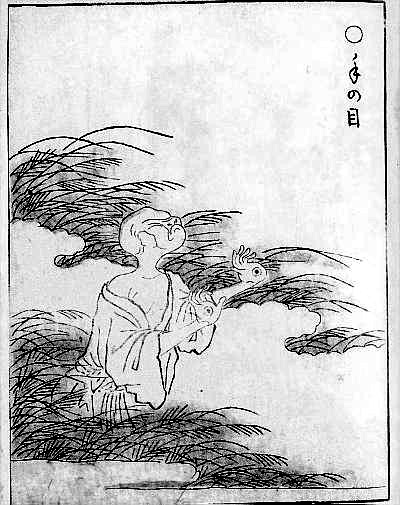Did you know that Stephen King himself squirmed when he saw the Pale Man scene in Pan’s Labryrinth? Hard same, Steve. When I first saw that movie, that scene disturbed me so much that it came back around and left me grinning ear to ear. The Pale Man is geniusly weird, with his sagging skin and eyes on his palms. Who could have thought him up?

It turns out the answer is the Japanese, some 250 years ago. The original monster was not a naked dude with skin folds conveniently covering his private bits, but a yokai that appears at first glance to be a zato (a member of a blind man’s guild). This not-zato can be found lurking in cemeteries, hands outstretched, as if he has only recently lost his vision and is searching for something. Get close enough, and you’ll find out in quick succession that a) he’s not blind, but looking with eyes embedded in his hands, and b) what he’s looking for is a snack like you.
Once the tenome (pronounced teh-no-may, not teh-gnome) has caught your scent, you’re finished. He moves fast, and even if he doesn’t catch you right away, he’s likely to find you later.
Eye have a bad feeling about this
Take the story of a bold youth who went to spend the night in a graveyard on a dare. The youth was getting settled in when he noticed an elderly blind man wandering around some distance away. Scoffing to himself–this was supposed to be a night of horror, not charity–he went to see if the zato needed help. The youth got close, calling out to him, and then the zato turned around. The youth froze–there were nothing but empty patches of skin where the zato’s eyes were supposed to be, and on his withered palms, reaching toward the youth’s face, where two bare, unblinking eyes.
The tenome lunged, and the youth ran. There was a temple nearby, and he ducked inside, crying out for help.
A monk answered his call. Alarmed, he listened to the young man’s account and realized at once that that they both had to hide, and fast. The monk hurried the youth into a large chest, and then hid himself. He knew his temple and its constituents well, so when a soft shuffle of feet appeared at the entryway, he knew that they belonged to a stranger.
The monk held his breath and begged his heart to beat more quietly. The shuffling neared, and then slowed to a stop. There was silence, then a long, breathy slurping sound, like a dog sucking the flesh off a bone.
The monk squeezed his eyes shut and waited for the touch of dry fingers, the soft, wet give of an eye. Instead, the shuffling resumed, moved back to the entrance, and faded away. The monk hesitated for a long time before coming out of his hiding place, unable to believe his luck. He and the youth had survived an encounter with a fearsome yokai! He hurried to lift the lid of the box, knowing that the young man would be anxious to get out.
His greeting died on his lips. The chest was empty save for a blubbery pile of skin–the only thing the tenome had left of the would-be adventurer.
That is the first commonly circulated story about the tenome. The second is more of an origin story, where a blind man is attacked by brigands and dies cursing them, wishing that he could see their faces, if only with his hands. He was granted his wish too literally and came back as a yokai. You can guess the rest.
A jest gets out of hand

The tenome first appeared in a 1776 yokai encyclopedia written by Toriyama Sekien. Sekien gave the tenome its name as a multi-layered wordplay joke at the expense of gamblers and priests. His accompanying illustration is also (via complex allusions) humorous, poking fun at cheaters and people who are so jumpy that they see ghosts everywhere. A good breakdown of the joke (such as it can be understood by people who only know English) can be found here; I am not able to do it justice.
Beyond that, Sekien gives us no other information–no context for where the tenome comes from or what it is. Perhaps he meant for it to be nothing more than a joke. But as is the danger with all jokes, some people didn’t get it. They took the tenome seriously. I’m glad that they did, because they gave the tenome a life of its own, and have created some wonderful things.
A hand-some legacy
Pan’s Labyrinth (and all the artwork spinoffs it created) is not the only modern place the tenome has appeared. The yokai also inspired one of the bosses from Cuphead (a video game featuring surrealist 1930’s rubber hose-style animation), and appears in the popular Pathfinder roleplaying game. Search “tenome” in Youtube, and you’ll come up several gameplay videos for an indie horror piece that came out a few years back (developed in a whopping 2 days!). You can play it for yourself here if you’d like to get some modern-day tenome action.
The Pale Man will always have a special place in my heart, but with so many versions of the tenome out there, it’s hard to pick a favorite. Maybe I should ask the universe for a guiding hand.

What would the incidence of bacterial conjunctivitis be in a population whose eyes are embedded in their hands? Share your estimates in the comments below.
IMAGE CRED: Ryan on Flickr for the Pale Man; Toriyama Sekien 300 years late for his clever tenome image; and 尾田淑 for the tenome image in color. Featured image by Stefano Pollio.





0 Comments